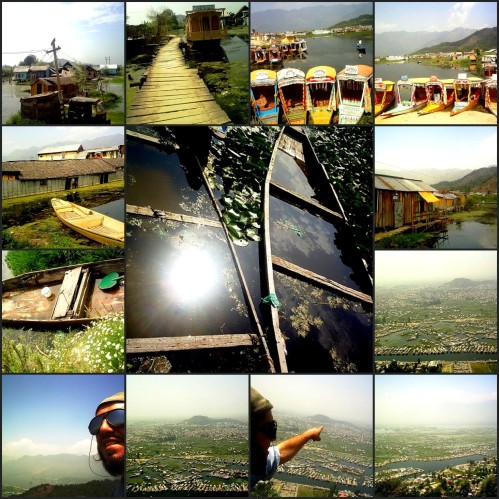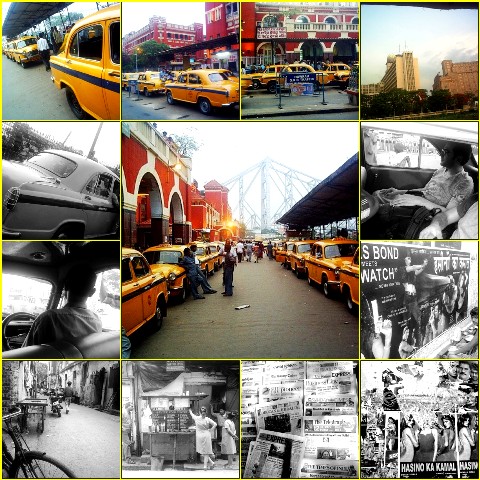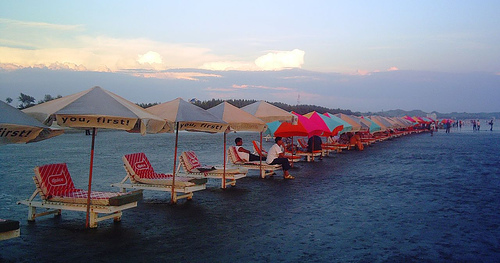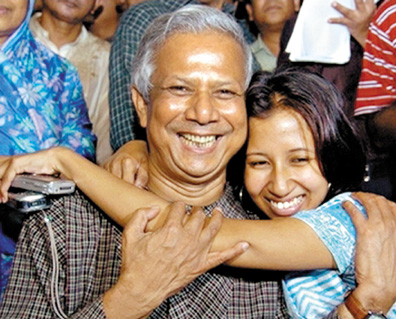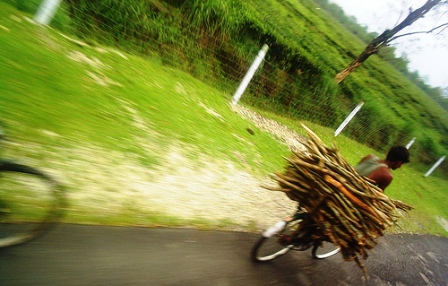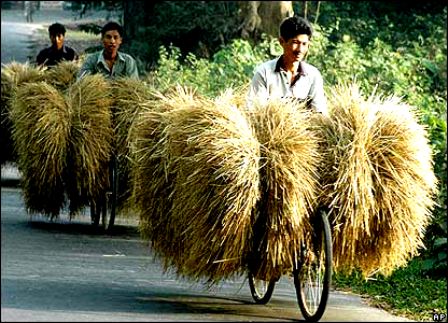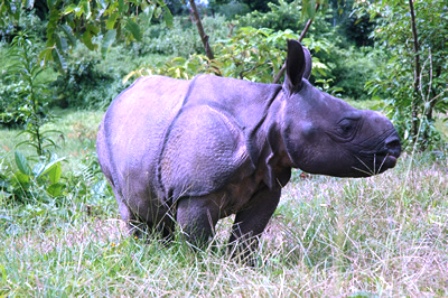Archive for May, 2007
People of Bengal: West Bengal, Bangladesh…whatever. Same people with the same language? Somehow true…but different religions? Very true this time. One has wait until coming to Calcutta (Kolkata), the quintessential city of Bengal: the cultural capital of all India. A vibrant city with a distinct socio-political culture, Kolkata is noted for its revolutionary history, ranging from the independence days , to the comunists (who are in power for over 40 years now) and unions movements- which in 2 seconds they paralyse a 14 milion people city with their hartals.
First impessions count very much when it comes to a city. For me was: Uha!, yes, i like that, look at that!, Hello from everywhere. Smiles, real ones, food stalls , people everywhere, the only place in the world to still find men pulled rickshaws. The people make the place said someone: All true. I have to say I love this place. The human touch is here. Finally…in India. I switched my camera to white&black and start shooting. This city is about its people. Their faces is what you’ll remember when you leave. You remember how in the middle of Calcutta there are hundreds of dhabas serving food for everybody: elbow by elbow-lawyers, policemen, richshaw wallahs, coolies, foreigner travelers, govt peons….etc. The good vibe is all there, above the poverty and all the existing problems the people face.
* I didn’t put the exclamation sign in order not to be confused with the the world’s longest Running erotic stage musical. Which is brilliant also>
Indian author and guru, born in Calcutta, Tagore came from a wealthy Bengali family. He went abroad in 1877 to study law in England but soon returned to India. For a time he managed his father’s estates and became involved with the Indian nationalist movement, writing propaganda. His characteristic later style combines natural descriptions with religious and philosophical speculation. Tagore drew on the classical literature of India, especially the ancient Sanskrit scriptures and the writings of Kalidasa. His prodigious output includes approximately 50 dramas, 100 books of verse (much of which he set to music), 40 volumes of novels and shorter fiction, and books of essays and philosophy.
In his devotion to peace, Tagore denounced nationalism and violence. He sought to instill in human beings a sense of their unity; he was severely critical of the Indian caste system. His most important philosophical work is Sadhana: The Realization of Life (1913), which echoes the fundamental ideas inherent in sacred Hindu writings. His dramas are filled with lyricism and philosophy, while his poems deal with amorous, mystical, and fabulous themes. In India his appeal was nearly universal. A man of striking appearance, Tagore came to be regarded with the reverence due an ancient teacher. He wrote in Bengali but translated much of his work into English. It attracted attention in the West, and he was awarded the 1913 Nobel Prize in Literature, especially for his collection of poetry, Gitanjali (1912). His Janaganamana (Thou Art the Ruler of All Minds) was adopted as the Indian national anthem.
The capital of Bangladesh is a fascinating place where 10 milions people vibrate in a humid, terribly hot and dusty scenario. Dhakka has this kind of raw power, during daytime everything is moving very fast- it’s very original in its own way- it’s like a struggle. Roads are packed, people come from every possible direction, and 2 milion rickshaw driven elbow by elbow with a constant unhumanly effort by sweaty wallahs. Old Dhakka is something every visitor will remember about the place, the bazaar areas the small eateries and the multitude of cromatics. The north, on the other hand is the residential area where all the NGO people live. Is made to fit the standards of expats and diplomats of all sorts. In between you have some good areas and neighborhoods and the central area with the University’s large campus and very green compounds, very good museums, parks, the national anssembly and people…people everywhere!
My experiences, in my time spent in Dhakka where split in 2 parts. My first days I was hosted by Uzzal, which is a very friendly person; He welcomed me in the heart of his family. I was treated like a brother, well fed and accommodated. This was the legendary muslim hospitality at its best. Uzzal’s family is hearty and kind: his wife and 2 lovely kids, 2 brothers and parents. Uzzal is also a world traveler and he wrote books about his travels-thing very rare in Bangladesh. He has also a traveling club and I met his nice friends, spending good time together talking about travels and the world we live in. His projects are also very interesting, and I was glad to encounter him.
Uzzal left on a trip to China after few days and I moved in the north partof the city to stay with an american friend, Micah, who’s teaching here for the last 2 years. Staying with him brought in front of my eyes another kind of Dhakka: I met many of his expats friends, hanging around at the embassy clubs where people play tennis, have lunch over a drink, or go out dancing on the rythms of salsa. I met interesting people like this, all working here for multinational companies or NGO’s ,or UN or garment outlets. And believe me, one wouldn’t imagine how alive a night out in Dhakka can be! And it goes to the wee hours. At the end you get back to your home, roaming around empty streets when all the slums sleep, and next morning you wake up take a walk out of the embassies enclave not believing this is the same city.
How much do you know about Bangladesh? Yes, people might say it’s that country in the news: “Massive floods hit Bangladesh, killing thousands of people and leaving millions stranded under no roof” would have been the headline in the news. I recognize myself, I sort of grew up with this kind of news about Bangladesh, neighbouring other headlines of the 80’s: the civil war in Lebanon, the sad Iran-Iraq conflict or the Nagorno-Karabah issue. Geography of the place is the answer to this, Bangladesh having 7% of its territory under water. All the major rivers crossing it, mighty Brahmaputra or Yamuna, form an incredible web navigable waterways criss-crossing the country. Rhe huge Bay of Bengal has at its mouth the largest delta in the world-Sundarbans- beeing also the largest mangroove forest and litoral. The volume of water flowing around bangladesh is equal to the volume flowing in entire Europe. It’s a nature wonder, and is the home to the national symbol of Bengal: the legendary Bengali Tiger. Other things might arouse to our ears about the country is poverty related topics. On the UN list for many years till very recently, Bangladesh had the (in)famous title of the poorest country on earth. They also head the table for the most corrupted country, still being very instable politically-and the battle for power is still disrupting the life of its people. After India was born as a republic, the exchange of population started on religious grounds making Bangladesh a very large muslim populated country. It was called East Pakistan, and authority from Pakistan overlooked the territory. After a long struggle for national identity, and a bloody fight for Bengali language over Urdu language, an intense conflict in ’71 set Bangladesh free and a new state was born. It’s one of the biggest muslim populated countries, only Indonesia and Pakistan having a larger population. While the first two are large, the problem is that in a country of medium size are harboured a wooping population of 144 millions souls. Adding that the continuosly deforestation is very dangerous, and the floods are never ending, relocating millions of people, the future doesn’t sounds great.
The fact that is very little visited is an advantage for adventure and soaking up local culture. It’s not shaped either for tourists needs, so the people are genuine. My fellows know that i have a deeply affection for muslims, result of my living in the Middle East, and a new destination for me is a delight. They are very welcoming, clean hearted people, but the media paranoia changed this. It started as soon as I was at the remoted visa office in remoted Agartala, where I was granted a Bangladeshi visa in my last day of the validity of my Indian one. The consul also arranged for me a bus to get to Dhakka. Half hour later I found myself-the only passenger-in an deluxe bus with a driver, a helper and a company representative. The country is almost entirely rural, wandering around paddy fields of glorious green, walking along villages makes it so…naturally. The kindness of the population is legendary and the nature set is supreme. Warm is in the air and in the heart. Humidity of over 95% makes the travel hard to the core, but hey…that’s adventure. It seems everywhere you are like in the green house of the Botanical Garden back home in Cluj.
South East of the country along the shores, passing Chandigarh, is a stretch of long shores running along the coast. It passes Cox’s Bazaar-the holiday place for te locals-and ends with St Martin Island, the only coral island in the country. This stretch of 120 km of un-interrupted beach is considered to be the longest beach in the world and at one point south of Cox’s Bazaar becomes (in the lowest tide) the widest beach! Along with this runs the Burmese border, all of it closed since the fifties, since Burma (Myianmar) has no land border open with any of its neighbors. Still, a lot of smuggling goes on around here. One can be temtped at the idea of just walk to Burmese teritorry, but land mines encounter is something to have in mind.
One of the highlights of a trip to Bangladesh is the cruise boat which runs from Dhakka to Khulna in an 30 hours journey, passing small busy ports of call on the way. The boat with the side engines is large, and the first class is splendid. All vintage of course.Small charming cabins, a dining area where all the passanger in the 1st class dine together at one long table, and very friendly staff. The roofed patio with armchairs is wanderful to overlook the vistas and the extremely reach wild life. Lower decks housing the 2nd and the deck class are crammed with local people, for them this is not a cruise but a transport way to their destinations. Ports are overwhelmingly crowded and watching this from the deck is fascinating. I got off before the final destination in Mongla which is the gate to The Sundarbans – “the beautiful forest.” It is a virgin forest which until recently owed nothing to human endeavour and yet nature has laid it out with as much care as a planned pleasure ground. For miles and miles, the lofty treetops form an unbroken canopy, while nearer the ground are works of high and ebb-tide marked on the soil and tree trunks and many varieties of the natural mangrove forest.The Sundarbans is a cluster of islands with an approximate area of 3600 sq. km. forming the largest block of littoral forests. It’s beauty lies in its unique natural surrounding. Thousands of meandering streams, creeks, rivers and estuaries have enhanced its charm. Sundarbans meaning beautiful forest is the natural habitat of the world famous Royal Bengal Tiger, spotted deer, crocodiles, jungle fowl, wild boar, lizards, rhesus monkey and an innumerable variety of beautiful birds. Migratory flock of siberian ducks flying over thousands of sail boats loaded with timber, gopatta (round-leaf), fuel wood, honey, shell and fish further add to the serene natural beauty of the Sundarbans. Many notorious companies organize safe and good trips, but being alone I had to organize it by miself with the fishermen in Mongla. It’s adventurous that you have to hire armed guards along with the trip. They are not as I thought for protection or to shoo away the deadly Begali Tiger, but also for protection against pirates. May reports show that people were held at the point of a gun.
Things are getting better for the agriculture nowadays since exists people like Dr Muhamad Yunus ( awarded with Nobel Prize for Peace in 2006) the owner of Grameen Bank, an example in micro-credit. They offer micro credits to groups af small families to start a small business. Grameencredit is based on the premise that the poor have skills which remain unutilised or under-utilised. It is definitely not the lack of skills which make poor people poor. Grameen believes that the poverty is not created by the poor, it is created by the institutions and policies which surround them. Grameen brought credit to the poor, women, the illiterate, the people who pleaded that they did not know how to invest money and earn an income. Grameen created a methodology and an institution around the financial needs of the poor, and created access to credit on reasonable term enabling the poor to build on their existing skill to earn a better income in each cycle of loans. Over 70 milions people are beneficiary of this. That’s an incredible number! So, ones the poorest country in the world gives an example of credit. Let’s not forget that also Amartya Sen, the famous economist, also awarded with a Nobel for economy was also born here. He is based in Calcutta.
It was quite a break after the Indian way of life to get to this Himalayans places all of sudden. Almost 2 month passed, and it was time to go southern ways again. The north eastern part of the India: Northeast region of India is a pristine territory, completely unexplored. The valley is adorned with lush green vegetation, majestic mountains and untamed rivers. It is also abode of exquisite range of flora and fauna and the magnificent tribal life. A varied number of tribes and tribal groups each with its own distinct culture inhabit the region of northeast India. Many tribal languages are spoken throughout these seven states. The northeastern states have the highest percentage of Christians. The region also has its state importance as it is bordering the territories of China, Tibet, Bhutan, Myanmar andBangladesh.
I was about to get through troubledAssam state, through the rainy Meghalaya (abode of clouds), finally reach to the (uninspired) Tripura. The north eastern states of India are worlds apart. I did not have the time, organization to visit the remoted ones: Arunachal, Mizoram, Manipur and Nagaland: all very exotic with oriental cultures, tribalism being their way of life. Assam I passed in hurry is actually what’s left of the British Assam (which had all the north eastern states include). Assam is the producer of 60% of the tea in India, and is home to Kaziranga National Park which harbours 1/3 of the world’s population of one-horned rhinos.
Shilong was my stop in Meghalaya. It was the former capital of British Assam. Just near here, 1 hour drive is the officially wettest point on earth. While the whole world knows of Cherrapunjee as the wettest place on earth, very little is known of Meghalaya the state it is in. Back to Shilong you step back (again) in time walking through all this great bungalow areas built by British. At one point this place was called the
Scotland of the East, the British ruled from here the entire north east. A long 20something hour bus ride in a military convoy brought me to Tripura, the southern state bordering Bangladesh which was my aim destination. I was back to the hot-humid weather after a long pleasant roaming around Himalayan freshy environment. It was time to forget the chowmein and momos diet. No more Buddhist chanting kissing my ears. Welcome to humid atmosphere of the Bay of Bengal.
